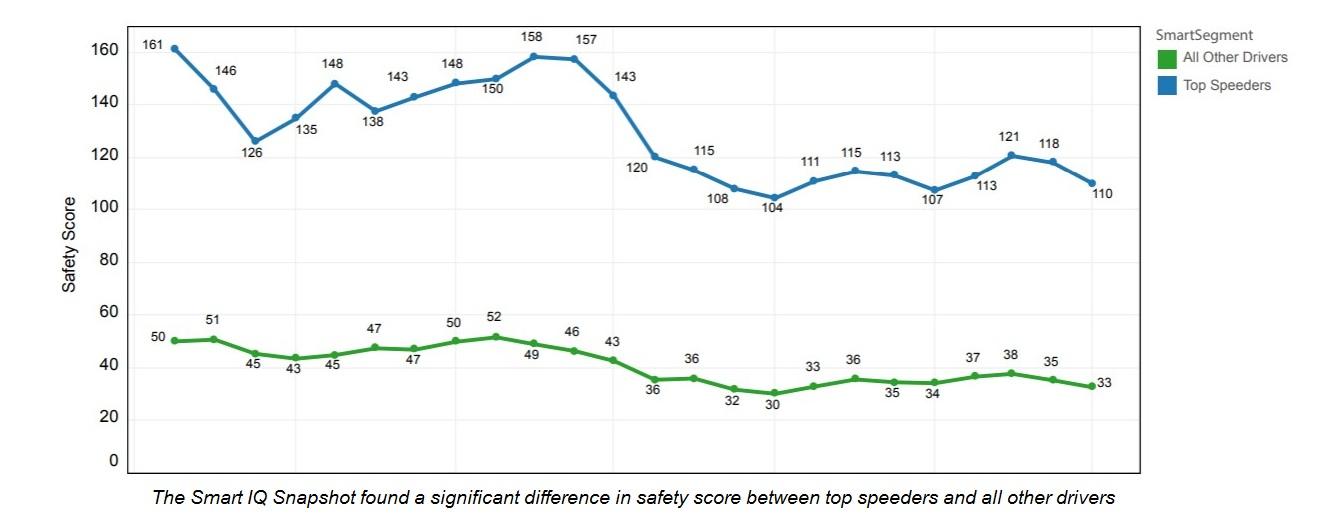
Want a Safer Fleet? Stop Speeding
The latest SmartDrive SmartIQ® Beat Snapshot analyzed and scored over 220 million events from the SmartDrive® database, with a particular focus on one of the most common and dangerous problem areas for drivers: speeding. Unsurprisingly, the Snapshot found several strong correlations connecting speeding with dangerous driving behavior, including collisions, lack of complete control of the vehicle, unsafe following distances and more. Whether in response to unplanned delays or other factors, there is no question that any perceived advantages associated with speeding are outweighed by the risks of driving too fast, which can include hefty fines, injuries and even fatalities. The question remains—how can fleets convince their drivers to slow down?

The Dangers of Driving Fast
The first step to creating a safer fleet is ensuring drivers understand just how risky it is to speed. According to SmartDrive’s Smart IQ Beat Snapshot, drivers who speed are found to be less safe overall, and are often connected with a significantly higher rate of driving errors, including:
- More collisions
- Speeding drivers are 45% more likely to be involved in a near collision
- Unsafe vehicle control
- Speeding drivers are 54% more likely to cross the median or center line of the roadway
- Unsafe following distance
- Speeding drivers are 3x more likely than all other drivers to maintain a following distance of less than one second
- Failure to stop at intersections
- Speeding drivers are 2.5x more likely to not attempt to stop at a stop sign than all other drivers
- Fuel waste
- Speeding drivers have a highway MPG that is 2.7% lower than all other drivers


Effective Methods to Prevent Speeding
Video-based Safety
Video is the only way for fleet managers to understand what’s really happening in the cab. With a video-based safety and analytics program, managers receive real-time insights to the context surrounding speeding. For example, are your drivers speeding when making lane changes? Are they more likely to speed when approaching an off-ramp? Do they appear to be distracted when they are speeding? This information can help inform constructive driver coaching sessions designed to change driving behaviors. With an easy-to-use managed service, leadership and drivers can access and self-manage driving performance at any time.
Incentives for Safe Driving
Fleets should not only provide the proper coaching and training for drivers who speed, but may also benefit from implementing an incentive program to recognize those who drive safely and within the speed limit. Positive reinforcement not only provides great perks for the employees who abide by the rules of the road, but creates an upbeat company culture that focuses on excellence and improvement, rather than punishment. Rewards for drivers who don’t speed can include bonuses, extra lunch time, meal credits, and more. Read more on building a successful data-driven driver incentive program.
Coaching
It’s not enough to just tell drivers to stop speeding; in order to see results on the roads, a quality coaching program needs to be implemented to show drivers how they can improve their performance. For fleets to take their coaching programs to the next level, utilizing video-based programs will allow drivers to see exactly where their specific problems exist. This will not only be beneficial to the drivers themselves, but will allow coaches to quickly identify areas of greatest opportunity and focus their time on what really matters—performance improvement that reduces risk. Watch this webinar and learn the 5 steps to improve your coaching and improve your drivers.
Take the First Step
The ideal approach to prevent speeding would include a combination of proper education, technology and company culture. A video-based safety program will help identify risky behavior, but without proper coaching and a company culture that consistently demonstrates a commitment to safety, drivers will continue to speed, endangering not only their own lives, but the lives of others sharing the road.
Take a look at the full Snapshot study.
- Posted by Melissa.Senoff@smartdrive.net
- On 10 July 2018